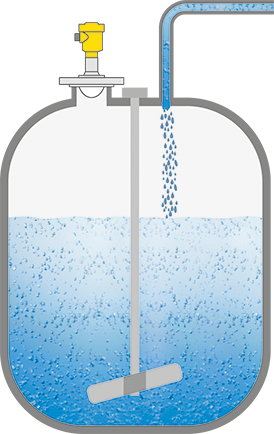Reliable measurement all the way down to the tank bottom
With older generation radars, in the case of poorly reflective liquids with very low dielectric constants, such as solvents or hydrocarbon products, part of the radar signal passes through the medium and is reflected from the metal highly reflective tank bottom. As the tank fills, the distance between the liquid level and the tank bottom increases, the two signals from the product surface and the tank bottom can be definitely separated and a reliable level measurement ensured.
However, at low liquid levels, the close proximity of the reflection signals means they can no longer be clearly distinguished – the result is an incorrect measurement, premature zero or a minimum measured distance the tank bottom.
Oil on the tank floor. At low levels, it is very difficult to measure oils or other liquids accurately.
The solution
Radar signals at higher frequency ranges experience a significantly higher signal attenuation when propagation occurs through low dielectric products. This means the 80-GHz frequency range of VEGAPULS 64 is a considerable advantage here, since the signal reflected from the tank bottom is considerably smaller than that generated by previous 26 GHz sensors. The product surface of different media can therefore be detected with higher accuracy right down close to the tank bottom
The benefits
-
Reliable level measurement of all media all the way down to the tank bottom
-
Utilization of the entire container volume, especially in small vessels
-
Easy adjustment with no minimum distance from the tank bottom
Related applications
Reactor
Level measurement in a stirring reactor
In a recycling company, oil sludge, oil/water mixtures and emulsions from many industrial processes are collected and treated. The objective is to separate the oil and water for recovery, purification and reuse. This process takes place in several steps. Firstly the oil/water mixture is centrifuged, hydrogen peroxide is added and mixed in a stirring reactor, then finally it is centrifuged again. Continuous level measurement is required in the reactor stage to enable automated operation. It’s very important for there to be an absolutely reliable and accurate measurement even at low liquid levels, right down to the vessel bottom.

Reliable
Reliable function, even with differently reflecting media, tank internals and agitators
Cost effective
Inexpensive integration into the reactor vessel, no modifications required
User friendly
Measuring point easily accessible
Export this article
Download as PDFShare this article
Comments ({{comments.length}})
{{getCommentAuthor(comment, "Anonymous")}} {{comment.timestamp | date : "dd.MM.yyyy HH:mm" }}
{{comment.comment}}






